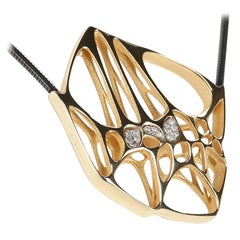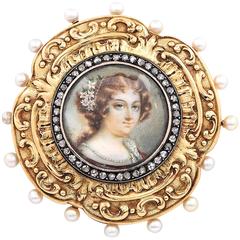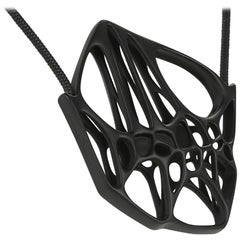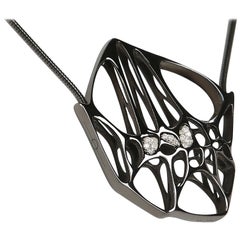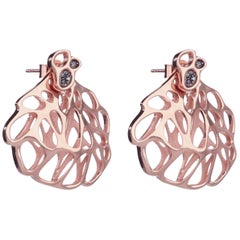Continental US - More Objets d'Art and Vertu
to
20
85
75
50
40
28
43
12
12
11
10
9
35
120
30
14
3
5
8
8
6
8
8
8
7
149
42
3
29
9
8
7
7
to
13
9
6
5
3
22
14
11
10
10
7
6
5
4
3
2
1
1
1
169
25
194
268
194
Item Ships From: Continental US
FLOWEN Sterling Silver Hexa Pendant Necklace in 18K Gold and Diamonds
By Flowen
Located in Los Angeles, CA
The HEXA S Pendant is FLOWEN's signature statement piece.
A 3 dimensional sculptural art object inspired by nature, driven by innovative design technologies and realized by a combina...
Category
21st Century and Contemporary Italian Contemporary Continental US - More Objets d'Art and Vertu
Materials
Diamond, 18k Gold, Gold Plate, Sterling Silver
1800s Miniature Pearl Diamond Gold Portrait Pin Cushion
Located in Bay Harbor Islands, FL
This miniature portrait of a young lady centers this unique gold pin 'cushion' with 14 removable pins, each topped with a pearl. Portrait is surrounded with small single cut old mine...
Category
Late 19th Century English Victorian Antique Continental US - More Objets d'Art and Vertu
Materials
Diamond, Cultured Pearl, 14k Gold, Yellow Gold
FLOWEN Sterling Silver Hexa Pendant Necklace Coated in Black Gommato
By Flowen
Located in Los Angeles, CA
The HEXA S Pendant is FLOWEN's signature statement piece.
A 3 dimensional sculptural art object inspired by nature, driven by innovative design t...
Category
21st Century and Contemporary Italian Contemporary Continental US - More Objets d'Art and Vertu
Materials
Sterling Silver, PVD-Coated
FLOWEN Sterling Silver Hexa Pendant Necklace in Black Ruthenium and Diamonds
By Flowen
Located in Los Angeles, CA
The HEXA S Pendant is FLOWEN's signature statement piece.
A 3 dimensional sculptural art object inspired by nature, driven by innovative design technologies and realized by a combina...
Category
21st Century and Contemporary Italian Contemporary Continental US - More Objets d'Art and Vertu
Materials
Diamond, Sterling Silver, Rhodium
Sterling Silver Decorated Vanity Box
Located in Coeur d Alene, ID
Eight sided silver lidded box with decorated sides and courting scene. Bottom marked "800 Germany" with maker's mark. Beautifully designed and perfect for a...
Category
Late 19th Century English Antique Continental US - More Objets d'Art and Vertu
Materials
Sterling Silver
FLOWEN Sterling Silver Aoda Studs and Earjackets in Rose Gold and Grey Diamonds
By Flowen
Located in Los Angeles, CA
The AODA Studs and Ear Jacket Earrings are intended to recall fossils or futuristic organisms. The intricate geometry radiates a 3 dimensional suspended sculpture when worn.
These vi...
Category
21st Century and Contemporary Italian Contemporary Continental US - More Objets d'Art and Vertu
Materials
Diamond, Sterling Silver, Rose Gold
Diamond Hat Pin 0.50 Carats 18 Karat White Gold Spear
By Merkaba
Located in Beverly Hills, CA
Very unique and stylish diamond spear hat pin, created by Merkaba Jewelry in 18K white gold. The round brilliant diamonds weigh a total of 0.50 carats.
Total length - 1.75" inches
R...
Category
21st Century and Contemporary American Art Deco Continental US - More Objets d'Art and Vertu
Materials
Diamond, White Diamond, 18k Gold, White Gold
$2,320 Sale Price
20% Off
Black Starr & Gorham Gothic Bold Wall Clock in Original Box
By Black, Starr & Gorham
Located in Long Beach, CA
FACTORY / HOUSE: Black Starr and Gorham
STYLE / REFERENCE: Gothic Motif
METAL / MATERIAL: Nickle Finished
CIRCA: 1940s/ 50s
MOVEMENT / CALIBER: High Grade 15 Jewels Swiss Made
DIAL / HANDS: Silvered Roman / Filigree Hands
DIMENSIONS: Length 16 Inches tall X Diameter 9 Inches Wide / 40cm X 23cm (box 17" X 11")
WARRANTY: 18 months on the movement.
This is am impressive wall clock sold by one of the premier American jewelry houses. Remarkably it comes with its original box, in excellent condition.
Black, Starr and Frost are considered America's oldest jewelry house. They merged with Gorham, one of America's oldest silver companies in 1929. Just in time for the Great Depression. This clock, or rather weather station as it is normally called, appears to have never been used. It was likely made in Switzerland of the finest materials some time mid century. Gothic in style while dating to later part of the Art Deco Era This would be an impressive piece in entry of an elegant old home. Or, conversely it would look great in an ultra modern entry...
Category
Mid-20th Century Swiss Gothic Revival Continental US - More Objets d'Art and Vertu
K. Brunini Twig Sterling Silver and Tahitian Pearl Salt Spoon
By K. Brunini Jewels
Located in Solana Beach, CA
From the K. Brunini Object d'Art collection comes this nature-inspired and uniquely designed collectible to grace your table top.
An heirloom for the table, or accent to the K. Brun...
Category
21st Century and Contemporary American Contemporary Continental US - More Objets d'Art and Vertu
Materials
Black Pearl, Pearl, Sterling Silver
$924 Sale Price
20% Off
Sterling Silver Decorated Vanity Box
Located in Coeur d Alene, ID
Eight sided silver lidded box with decorated sides and minstrel scene. Bottom marked "800 Germany" with maker's mark. Beautifully designed and perfect for a vanity piece or pill box....
Category
Late 19th Century English Antique Continental US - More Objets d'Art and Vertu
Materials
Sterling Silver
Victory Favrile Glass Medallion by Louis Comfort Tiffany & Co.
By Louis Comfort Tiffany
Located in New Orleans, LA
Art Nouveau pioneer and gifted American artisan Louis Comfort Tiffany created this Victory favrile glass medallion in celebration of the Allied victory in World War I. Tiffany's majestic iridescent art glass highlights the patriotic motif featuring an eagle, with its wings outstretched, holding aloft the Liberty Bell above the banner inscribed "VICTORY" above the year 1918. It is believed that this medallion was commissioned by Tiffany as an invitation to an exclusive party celebrating the end of the war. Few of these remarkable objets d'art are known to exist, making them not only exceptional works of Tiffany Studios artistry, but also stunning artifacts of world history.
Set in a gilt bezel, this medallion can be worn as a pendant.
Inspired by the fluidity and translucence of ancient Roman and Middle Eastern glass...
Category
Early 20th Century American Art Nouveau Continental US - More Objets d'Art and Vertu
Materials
Gilt Metal
Tiffany & Co. Sterling Silver Bowl
By Tiffany & Co.
Located in Dallas, TX
Tiffany & Co. Sterling Silver Bowl - Tiffany & Company Sterling silver 2 inches bowl or centerpiece. Mid century modern styling with dra...
Category
21st Century and Contemporary American Continental US - More Objets d'Art and Vertu
Mellerio Paris, a French Gold, Diamonds, Silver, and Smoky Quartz Carved Horse
By Mellerio dits Meller
Located in Queens, NY
Mellerio Paris, A French Gold, Diamonds, Silver-Gilt, Rock-Crystal, Jade, Mother-Of-Pearl and Smoky Quartz, Carved Horse Sculpture, Jeweled Mounted Object.
An extremely rare and unique, one of a kind French gold, diamonds, Silver-gilt, rock-crystal, jade, obsidian, mother-of-pearl, and smoky quartz carved jeweled sculpture "CHEVAUX DE LEGENDE", "A Legendary Horse" by Mellerio, Paris, circa 1991.
Sitting on black obsidian base, the solid rock-crystal slab is finely applied with a carved smoky -quartz and jade horse with a harness mounted in 18k gold, brilliant -cut diamonds, rubies, turquoise, and amethyst chains and pendants. The top columns adorned with 18k gold and brilliant cut diamond pendants, the bottom with gold and mother of pearl plaques. The obsidian base with a plaque engraved: CHEVAUX DE LEGENDE" / N° 05 / MELLERIO DITS MELLER / PARIS / 5003 D
The piece is in excellent condition and comes with a custom made wood case made for transport. It's very elegant and has French hallmarks throughout. A truly magnificent piece.
Measures 10.5" high x 8.5" wide x 4" deep
Founded in France in 1613 by the descendants of Italian immigrants from the Vigezzo Valley in the north of Italy, Mellerio is one of the oldest jewellery houses in Europe. The family business soon attracted the attention of the Royal Court and Marie Antoinette herself reportedly purchased a precious bracelet featuring 7 cameos surrounded by rubies in 1780. Later on, in the 19th century, Mellerio became the official supplier of the French Royal family and the Court of Netherland.
Mellerio creates many jewellery items, all set with rare gems such as peridots, amethysts, aquamarines, citrines and topaz, applying for a patent, the flexible stem, a very supple and light jewellery mechanism. Mellerio remains also well known for their spectacular series of Art Nouveau jewels, created at the beginning of the 20th century, as well as for the creation of trophies rewarding some of the greatest footfall and tennis players of history. In 1993, the jewellery house launched their first watch collection.
Today, Mellerio has stores in Paris, Japan and Hong Kong.
July 14, 1789: this date is known throughout the world as the beginning of the French Revolution. According to a ledger belonging to House of Mellerio, this was also the day that the jeweler sold a golden key to the Comte de Coutance for 10 livres. This ledger, as well as inventories dating as far back as 1768, are the jeweler’s oldest archives. These archives have continued to grow over the years, as the House, established on rue de la Paix in Paris, still lives on today, still in the hands of the same family from Craveggia, in the North of Italy.
The tumultuous history of the Mellerio family in France probably goes as far back as the Italian wars of the Renaissance, but the first official document proving their commercial activity in Paris dates back to 1613. This document is the famous royal warrant awarded by Marie de Medici to a number of Italian families established along the rue des Lombards, including the Mellerios, allowing them to sell “small jewelery items”, therefore granting them a small exception to the traditional monopoly enjoyed by Parisian jewelers. At that time, powerful corporations regulated the operations and customs of Parisian business, but thanks to this exceptional warrant, the Mellerios managed to escape the confines of this framework. Today, this wax-sealed document is kept at the city hall of Craveggia.
From 1613 to the Revolution, the Mellerios lived between France and Italy. The corporations tried many times to put an end to their trade privileges, but all in vain, as a dynasty of sovereigns renewed the warrant. Always marrying and often retiring in Craveggia, the Mellerios continued to maintain their jewelry business in Paris. At first, they did this without a shop. Wearing backpacks (wooden boxes divided into small compartments where jewels were kept), they would tour town fairs around Paris and royal castles.
This is how Jean-Baptiste Mellerio (1765-1850) is said to have sold a bracelet set with rubies and Antique cameos to Marie-Antoinette, which still exists today. Many elements seem to prove the veracity of this anecdote. The queen was particularly fond of cameos, which cover the entire background of her famous jewelry cabinet, and ruby was her favorite stone after diamond. The famous bracelet, reacquired a few years ago by the House of Mellerio, is indeed an 18th century jewel, set with antique cameos representing the profiles of Roman emperors. Two branches of the family were operating in Paris during this time, under the reign of Louis XVI: that of Jean-François (1746-1828), the paternal ancestor of the current Mellerios, and that of Jean-Baptiste (1765-1850).
The French Revolution forced them to return to Italy. However, both Jean-Baptiste and François Mellerio (1772-1843), who was the son of Jean-François, were eventually able to return to Paris after the founding of the Consulate. Jean-Baptiste opened a shop at the Iron Crown of rue Vivienne, and François opened his at the Palais des Tuileries, rue du Coq Saint-Honoré. His well-organized order books give an idea of his high-ranking clientele during the “Old Regime”, among which were the Comte and Comtesse Octave de Segur, the Marquise (later Duchess) de Tourzel, former governess of the royal children, and her daughter, the Comtesse de Bearn, the Craufurds -who organized the flight to Varennes, the Duc and Duchess de Gramont, the Comtesse de Boigne, and Madame de Souza, Talleyrand’s mistress.
We also see the names of the imperial family: Empress Josephine, the Queen of Holland, Princess Elisa, Caroline and Pauline. At that time, the House of Mellerio specialized, among other things, in the trade of antique cameos, a newly fashionable genre of jewel that captured the imagination of all the princesses and noble women of the time.
The years of the Restauration and July Monarchy were among the most glorious. The Bourbons were back on the throne, and the clientele of the House of Mellerio had regained its former wealth. Mellerio supplied Louis-Philippe, Duke of Orléans, as well as his mother, wife and sister, with sumptuous jewels, including a set of emeralds made piece by piece, while the Duke of Bourbon, last prince of the House of Condé, offered diamonds to his mistress, the scheming Baronne de Feucheres, and Monsieur de LaFayette also bought cameos for one of his granddaughters. For the first time, Mellerio ventured into the world of arts in 1815, when Carlotta Grisi, a famous dancer who created Giselle, as well as an actress named Rachel, bought jewels at the Mellerio store on rue de la Paix.
1848 marked a new turning point. France once again became a Republic. François Mellerio handed the company over to his son, Jean, and the latter decided to travel to Spain to build a new clientele. He later became one of the jewelers of the royal family, and met Eugénie de Montijo, who remained a faithful client when she became empress of the French people. The Imperial years were lavish. During the Second Empire, Paris was a pageant of crinoline dresses designed by Worth, while jewels by Mellerio, Worth’s neighbour on the rue de la Paix, adorned the noble women of the Tuileries court.
The Empress bought pearls. Mathilde Bonaparte...
Category
20th Century French Continental US - More Objets d'Art and Vertu
Materials
Amethyst, Diamond, Jade, Quartz, Rock Crystal, Ruby, Turquoise, Gold, Si...
Mellerio Paris, a French Gold, Diamond, Silver-Gilt, Rock-Crystal, & Lapis Horse
By Mellerio Paris
Located in Queens, NY
Mellerio Paris, A French Gold, Diamond, Silver-Gilt, Rock-Crystal, Obsidian & Lapis Horse
An extremely rare and unique, one of a kind French gold, diamonds, Silver-gilt rock-crystal, obsidian and lapis lazuli jeweled sculpture "Bucéphale, Chevaux de légende", "Bucephalus, A Legendary Horse" by Mellerio, Paris, circa 1998.
Sitting on black obsidian base, the solid rock crystal slab is finely applied with a lapis lazuli half-horse with harness mounted in 18k gold and brilliant cut diamonds, between two crystal and lapis lazuli columns adorned with gold and diamonds, insert with 7 ruby cabochons and 1 emerald cabochon, the obsidian base with a plaque engraved: CHEVAUX DE LEGENDE / MELLERIO DITS MELLER / PARIS / 5029 DIV
Bucephalus (c355-326 BC) is among the most famous horses in history, and it was said that this he could not be tamed. The young Alexander the Great, of course, tamed him – and went on to ride his beloved equine companion for many years and into many battles.
The piece is in excellent condition and comes with a custom made wood case made for transport. It's very elegant and has French hallmarks throughout. A truly magnificent piece.
Measures 10" high x 9" wide x 4" deep
Founded in France in 1613 by the descendants of Italian immigrants from the Vigezzo Valley in the north of Italy, Mellerio is one of the oldest jewellery houses in Europe. The family business soon attracted the attention of the Royal Court and Marie Antoinette herself reportedly purchased a precious bracelet featuring 7 cameos surrounded by rubies in 1780. Later on, in the 19th century, Mellerio became the official supplier of the French Royal family and the Court of Netherland.
Mellerio creates many jewellery items, all set with rare gems such as peridots, amethysts, aquamarines, citrines and topaz, applying for a patent, the flexible stem, a very supple and light jewellery mechanism. Mellerio remains also well known for their spectacular series of Art Nouveau jewels, created at the beginning of the 20th century, as well as for the creation of trophies rewarding some of the greatest footfall and tennis players of history. In 1993, the jewellery house launched their first watch collection.
Today, Mellerio has stores in Paris, Japan and Hong Kong.
July 14, 1789: this date is known throughout the world as the beginning of the French Revolution. According to a ledger belonging to House of Mellerio, this was also the day that the jeweler sold a golden key to the Comte de Coutance for 10 livres. This ledger, as well as inventories dating as far back as 1768, are the jeweler’s oldest archives. These archives have continued to grow over the years, as the House, established on rue de la Paix in Paris, still lives on today, still in the hands of the same family from Craveggia, in the North of Italy.
The tumultuous history of the Mellerio family in France probably goes as far back as the Italian wars of the Renaissance, but the first official document proving their commercial activity in Paris dates back to 1613. This document is the famous royal warrant awarded by Marie de Medici to a number of Italian families established along the rue des Lombards, including the Mellerios, allowing them to sell “small jewelery items”, therefore granting them a small exception to the traditional monopoly enjoyed by Parisian jewelers. At that time, powerful corporations regulated the operations and customs of Parisian business, but thanks to this exceptional warrant, the Mellerios managed to escape the confines of this framework. Today, this wax-sealed document is kept at the city hall of Craveggia.
From 1613 to the Revolution, the Mellerios lived between France and Italy. The corporations tried many times to put an end to their trade privileges, but all in vain, as a dynasty of sovereigns renewed the warrant. Always marrying and often retiring in Craveggia, the Mellerios continued to maintain their jewelry business in Paris. At first, they did this without a shop. Wearing backpacks (wooden boxes divided into small compartments where jewels were kept), they would tour town fairs around Paris and royal castles.
This is how Jean-Baptiste Mellerio (1765-1850) is said to have sold a bracelet set with rubies and Antique cameos to Marie-Antoinette, which still exists today. Many elements seem to prove the veracity of this anecdote. The queen was particularly fond of cameos, which cover the entire background of her famous jewelry cabinet, and ruby was her favorite stone after diamond. The famous bracelet, reacquired a few years ago by the House of Mellerio, is indeed an 18th century jewel, set with antique cameos representing the profiles of Roman emperors. Two branches of the family were operating in Paris during this time, under the reign of Louis XVI: that of Jean-François (1746-1828), the paternal ancestor of the current Mellerios, and that of Jean-Baptiste (1765-1850).
The French Revolution forced them to return to Italy. However, both Jean-Baptiste and François Mellerio (1772-1843), who was the son of Jean-François, were eventually able to return to Paris after the founding of the Consulate. Jean-Baptiste opened a shop at the Iron Crown of rue Vivienne, and François opened his at the Palais des Tuileries, rue du Coq Saint-Honoré. His well-organized order books give an idea of his high-ranking clientele during the “Old Regime”, among which were the Comte and Comtesse Octave de Segur, the Marquise (later Duchess) de Tourzel, former governess of the royal children, and her daughter, the Comtesse de Bearn, the Craufurds -who organized the flight to Varennes, the Duc and Duchess de Gramont, the Comtesse de Boigne, and Madame de Souza, Talleyrand’s mistress.
We also see the names of the imperial family: Empress Josephine, the Queen of Holland, Princess Elisa, Caroline and Pauline. At that time, the House of Mellerio specialized, among other things, in the trade of antique cameos, a newly fashionable genre of jewel that captured the imagination of all the princesses and noble women of the time.
The years of the Restauration and July Monarchy were among the most glorious. The Bourbons were back on the throne, and the clientele of the House of Mellerio had regained its former wealth. Mellerio supplied Louis-Philippe, Duke of Orléans, as well as his mother, wife and sister, with sumptuous jewels, including a set of emeralds made piece by piece, while the Duke of Bourbon, last prince of the House of Condé, offered diamonds to his mistress, the scheming Baronne de Feucheres, and Monsieur de LaFayette also bought cameos for one of his granddaughters. For the first time, Mellerio ventured into the world of arts in 1815, when Carlotta Grisi, a famous dancer who created Giselle, as well as an actress named Rachel, bought jewels at the Mellerio store on rue de la Paix.
1848 marked a new turning point. France once again became a Republic. François Mellerio handed the company over to his son, Jean, and the latter decided to travel to Spain to build a new clientele. He later became one of the jewelers of the royal family, and met Eugénie de Montijo, who remained a faithful client when she became empress of the French people. The Imperial years were lavish. During the Second Empire, Paris was a pageant of crinoline dresses designed by Worth, while jewels by Mellerio, Worth’s neighbour on the rue de la Paix, adorned the noble women of the Tuileries court.
The Empress bought pearls. Mathilde Bonaparte...
Category
21st Century and Contemporary French Continental US - More Objets d'Art and Vertu
Materials
Diamond, Lapis Lazuli, Rock Crystal, Gold, Silver
Recently Viewed
View AllMore Ways To Browse
Vintage Mouse Brooch
Vintage Original By Robert Brooch
Vintage Philippe Ferrandis
Vintage Ram Brooches
Vintage West Germany Brooch
Vintage Yosca
Viper Bracelet
Ylang Ylang
Yosca Jewelry Vintage
Ysl Vintage Earrings Logo
Ysl Wood Necklace
18k Gold Tiffany Money Clips
1911 Gold Coin
22 K Gold Bracelet
24k South Sea Pearl
3 Vintage Chicks
965 Jewelry
Agate Bird Brooch
